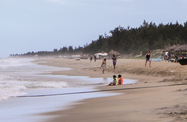New air routes and relaxed visa restrictions in Vietnam are boosting foreign arrivals and supporting growth in the country’s tourism industry, though there are concerns that overexploitation of cultural and environmental resources could devalue the sector’s key assets.

Foreign arrivals in the first half of 2017 jumped 30.2% year-on-year (y-o-y) to roughly 6.2m, according to the General Statistics Office (GSO). Inbound traffic continued to be dominated by the traditional core market of North-east Asia, which made up 58.5% of total arrivals, though the fastest growth came from other markets: Russia, South-east Asia and Australasia all posted expansion in the double digits.
This surge in arrivals helped push tourism revenues up by 27% y-o-y in that period, GSO data show, reaching earnings of VND254.7trn ($11.2bn). The spike in visitors continues a recent growth trend: in 2016 the country hosted 10m overseas travellers, a 26% increase on the previous year.
Growth projections
If such growth continues, Vietnam would be well on its way to meeting its end-of-decade objectives.
According to official forecasts per the Vietnam National Administration of Tourism, arrival numbers should increase to 17m-20m by 2020, while domestic travel will rise to 82m trips, up from 62m in 2016 – a dual increase that, it predicts, could see revenues rise to $35bn, or 10% of GDP.
The World Travel & Tourism Council’s 2017 report on Vietnam said the sector’s total GDP contribution was 9.1% last year, driving revenues of VND410.01trn ($18.1bn), not far short of the 2020 target.
New flight routes
The flow of visitors has been enabled by an increase in the range of flights serving Vietnam. Airlines that have recently announced new routes include South Korea’s Eastar Jet, operating between Seoul and Da Nang; local airline Jetstar Pacific, flying from Osaka to both Hanoi and Da Nang; and Air New Zealand, which launched flights on the Ho Chi Min City-Auckland route.
By the end of June, according to the GSO, foreign arrivals by air were up 33% y-o-y, to 5.21m, while those coming by sea and road grew 26% and 15.8%, respectively, for a combined total of just under 1m.
Greater market access
Some of this growth can be attributed to government efforts to facilitate open access. In mid-May Vietnam announced it was extending a policy of visa-free travel for five EU member countries – Germany, France, Italy, Spain and the UK – by 12 months. The programme had been scheduled to end on June 30.
Under the original provisions, visitors from these countries could stay in Vietnam for up to 15 days without a visa. The extension expanded this to 30 days, something the private sector had lobbied for and which the local travel industry welcomed.
Easier access has already helped drive growth from these markets, with inbound traffic from Spain up 29.2% in the first five months of 2017, followed by Germany (17.4%), Italy (16.1%), the UK (12.7%) and France (10.1%).
Local tourism assets
Amid significant progress in developing and promoting the country’s tourism offer, a 2017 report by the European Chamber of Commerce in Vietnam recommended an increase in state backing for tourism.
Government objectives for the sector, it said, could be furthered by enhancing promotional efforts and investing in long-term projects, including through cultural and environmental preservation, product development and infrastructure-building.
It also cautioned, however, of a need to balance growth against environmental impacts as Vietnam’s appeal as a tourism destination rises, adding that private and public investments in hospitality facilities are growing, especially in the coastal regions.
“Development has often failed to acknowledge the tourism, lifestyle and economic value of the heritage and historic assets Vietnam is home to,” the report stated. “With careful planning and sustainable development, tourism has the ability to not only attract more travellers to Vietnam but also act as the window to the world and a bright future.”


